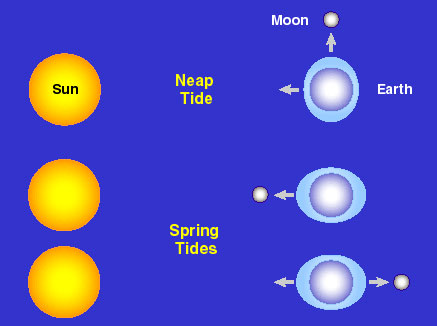Ocean tides metaphorically symbolise the cyclical nature of human experiences and emotions, highlighting both the beauty and tumultuousness of life. But what are ocean tides, how are they formed, and what is their impact on life on Earth?
Ocean tides are the periodic rising and falling of Earth’s sea level caused by the gravitational interactions between the Earth, Moon, and Sun. Here’s a simplified explanation:
- Gravitational pull: The Moon’s gravity pulls on the Earth’s oceans, creating a “bulge” in the water towards it on the side nearer to it.
- Second bulge: The rotating Earth creates a second bulge on the opposite side of the planet farther from the Moon, which experiences comparitively lesser gravitational pull of the Moon.
- Tidal cycle: As the Earth rotates, different parts of the planet experience the gravitational pull of the Moon differently, resulting in a cycle of rising and falling sea levels.

- Sun’s effect: The Sun also exerts a gravitational force, although weaker than the Moon’s, because it is much farther from the Earth than the Moon. However, when the Sun and the Moon are aligned (at new moon or full moon), their forces work together, amplifying the tidal range, which are then called spring tides. The opposite occurs as neap tides with low tidal range when the Sun, the Earth and the Moon form a right-angle. Tidal range is the difference in height between high and low tide at a specific location.
- Tidal patterns: The combined effects of the Moon and Sun create different tidal patterns in different parts of the world, including:
- Semidiurnal tides (two high and two low tides daily)
- Diurnal tides (one high and one low tide daily)
- Mixed tides (a combination of semidiurnal and diurnal patterns)
- Other factors: Ocean tides are also affected by the local weather patterns and the shape of the coastline.
Ocean tides have a profound impact on life on Earth, benefiting it in numerous ways:
- Marine ecosystems: Tides create diverse habitats for marine life, from coral reefs to estuaries, supporting a wide range of species.
- Nutrient cycling: Tides help distribute nutrients, sediments, and organic matter, enriching coastal ecosystems.
- Shoreline stabilisation: Tides help maintain shoreline stability, preventing erosion and protecting coastal communities.
- Water quality: Tides aid in flushing out pollutants and sediments, maintaining water quality.
- Food security: Tides support commercial fisheries and aquaculture, providing a vital source of food.
- Coastal protection: Tides help protect coastlines from wave action, reducing damage from storms.
- Carbon sequestration: Tides play a role in ocean carbon sequestration, mitigating climate change.
- Recreation and tourism: Tides create opportunities for recreation, tourism, and economic growth.
- Scientific research: Studying tides advances our understanding of ocean dynamics, climate and Earth’s rotation.
- Indigenous cultures: Tides have cultural and spiritual significance for many indigenous communities, supporting traditional ways of life.
In summary, ocean tides help in maintaining the health of marine ecosystems, support biodiversity, and benefit human communities.
Image courtesy: https://www.pas.rochester.edu/
For more details on the subject, visit https://www.wtamu.edu/~cbaird/sq/2013/05/09/why-does-the-moons-gravity-cause-tides-on-earth-but-the-suns-gravity-doesnt/
